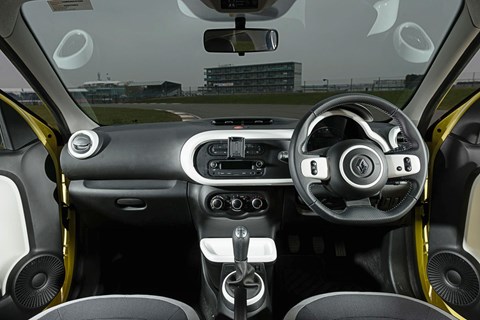My dad used to have a Renault Avantime, the weird coupé Espace, and though it was a car with *merits* (I’m being generous for his sake) it was not a big seller. Likewise the Vel Satis luxury saloon that went on sale at the same time. Combined, there are about 700 of them left in the UK.
As well as the quirky styling and the questionable market positioning, Renault was also up against a fundamental prejudice in the minds of the British public: French luxury cars. The Germans do luxury; the Brits do luxury; even, arguably, the Italians; but the French? They make cars for peasants, don’t they?
Which is why the Twingo feels so right. Yes, I know the Twingo is a half German car, but there was a good reason Renault teamed up with Smart on this rear-engined five-door hatch, rather than teaming up with Rolls-Royce on a £300k luxury fastback. The Twingo is what Renault has always traditionally done best: a simple, economical city car with real character.
And that’s how we’ve all felt about our yellow bumblebee. Nipping into town for a baguette and a bottle of plonk is a journey that’s written into this car’s genes, with its thrummy three-cylinder engine and its astonishing dog-chasing-tail turning circle. Its interior is well-judged too – pared back and functional on the one hand, yes, but not plain or boring, and sometimes straight forward functionality is what we all crave – like when you just want to get in and connect your iPhone. In this sense, the Twingo has proved to be bang-up-to-date and easy to live with.
Take it further than your local boulangerie or (as we call them in Britain) ‘the bread shop’ and its limitations are exposed. One or two of CAR’s drivers commented on the waywardness of the Twingo at motorway speeds, when – with a nasty sidewind or even in another car’s wake – the Renault feels like it’s not completely tied down to the road. And motorway speeds themselves aren’t easy to maintain, especially if you hit a long uphill slope. Whenever I took the Twingo on a big, cross-country motorway drive, I found my right foot mashing the accelerator to the carpet the whole time, with absolutely nothing left in reserve.
But for me, the Twingo has one fundamental flaw that stops it from being a truly great car – the loose-feeling, finger-light steering that requires you to swirl your arms round and round. There was a reason that the original Mini became a legend, and it wasn’t just because of the clever packaging – it was great to drive too, in a go-kart kind of way. In comparison, the Twingo is easy to drive, yes, but it also feels disconnected, and slow to respond. Shame – if the engineers had been ballsy with a really direct steering rack, it could have been absolutely amazing. But then, Renault tried ‘ballsy’ before, and look where it got them.
Still, we’ll miss the little Renault, and we send it on its way with happy memories.
@markwalton_
Final logbook: Renault Twingo Play SCE 70
Engine: 999cc 12v 3-cyl, 69bhp @ 6000rpm, 67lb ft @ 2850rpm
Transmission: 5-speed manual, rear-wheel drive
Stats: 14.5sec 0-62mph, 94mph, 105g/km
Price: £9995
As tested: £10,585
Miles this month: 628
Total miles: 7770
Our mpg: 42.6
Official mpg: 62.8
Fuel costs overall: £936.75
Extra costs: £0
Count the cost
Cost new £10,585 (including £590 of options)
Dealer sale price £6633
Private sale price £6133
Part-exchange price £5738
Cost per mile 12p
Cost per mile including depreciation 76p
Read more from the June 2016 issue of CAR magazine
